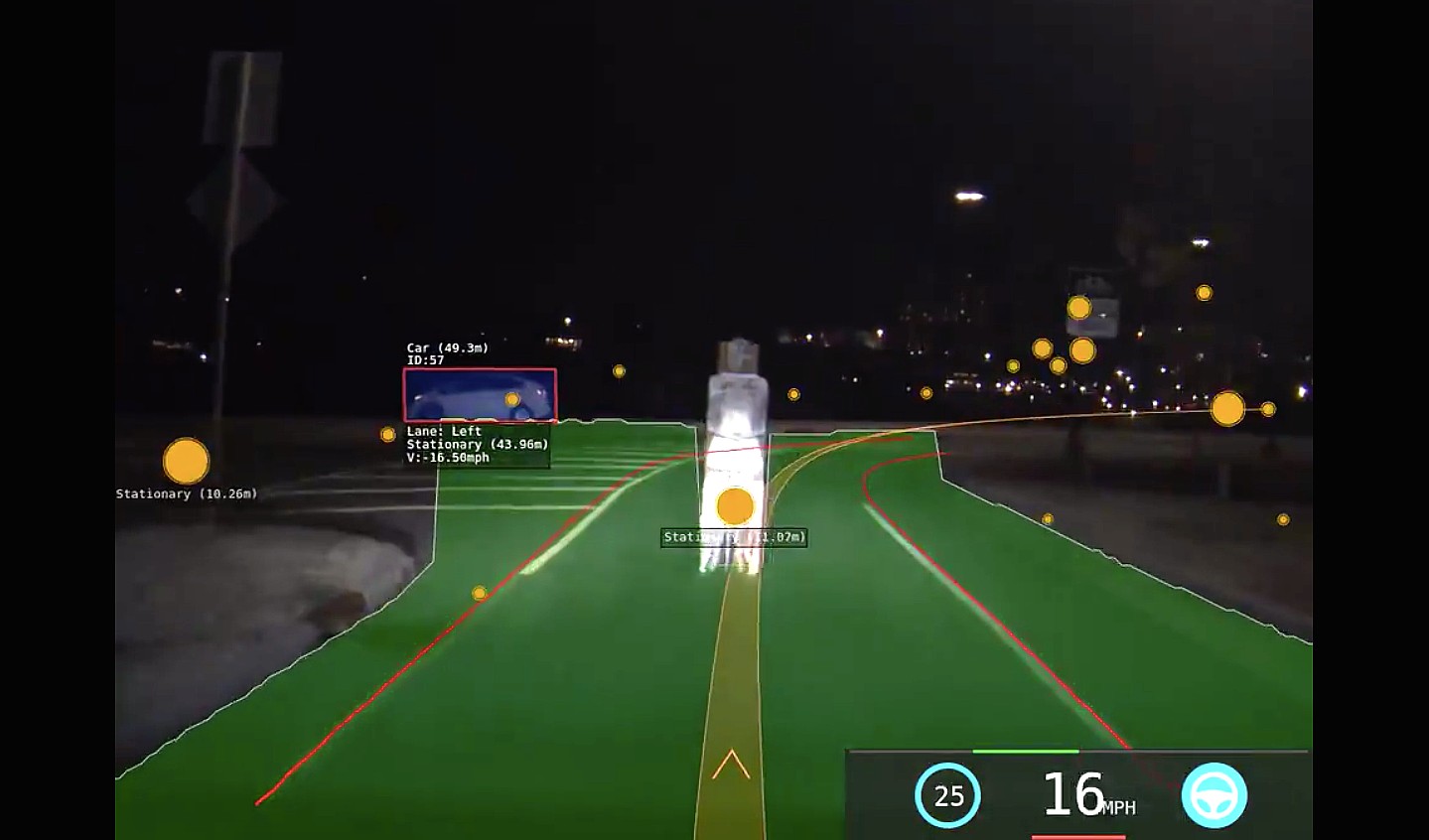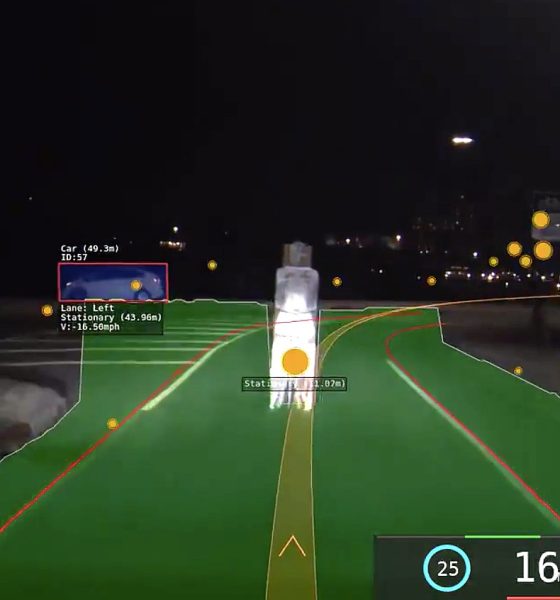

News
Watch Tesla’s Automatic Emergency Braking kick in for a fake pedestrian
Tesla’s Autopilot and Automatic Emergency Braking (AEB) features were recently highlighted in a video depicting the system’s ability to avoid collisions with pedestrians and obstacles.
In a series of videos posted on Twitter, Tesla community member and resident hacker @greentheonly demonstrated how Autopilot, under version 2019.40.1.1, safely and successfully avoided contact with a cardboard dummy fondly referred to as “Sir Steady”. When being driven steadily on Autopilot, the vehicle recognized the pedestrian and slowed down, showing that the vehicle’s computer successfully recognized Sir Steady from a distance.
On one attempt, AEB abruptly stopped the vehicle when Autopilot detected the fake pedestrian. While the use of the AEB system managed to avoid contact with Sir Steady, Autopilot did not recognize him. Fortunately, AEB did manage to keep the pedestrian safe and avoid any damage to the vehicle.
We'll start with the ideal case. Car on AP, driving steadily when we encounter pedestrian firmly in our way.
We can see him from far away so we gracefully slow down, just like a real human! Perfect score! This happened 3 times out of 4. pic.twitter.com/w3ttt3ieAx— green (@greentheonly) December 6, 2019
Making the experiment more difficult, @greentheonly then moved Sir Steady on the side of a lane. This test showed that Autopilot and AEB both still need improvement. The vehicle collided with Sir Steady on all four attempts. Interestingly, AP did recognize an obstacle because the vehicle beeped when approaching the dummy. It just failed to stop in time. The AP view confirmed to the Tesla enthusiast that lane positioning within the software was incorrect, even though Sir Steady was clearly in the road.
This happened 4 out of 4 times. Let's examine the metadata.
Here we see that the lane positioning is all wrong even while we can see him firmly in our lane. Also radar-vision fusion happened later than expected.This somewhat confirms AP tendency to misjudge offset objects pic.twitter.com/vxHrHrEzXe
— green (@greentheonly) December 6, 2019
In the past, AEB has saved numerous Tesla owners from violent accidents. According to Tesla’s Owners Manual, the AEB system utilizes a series of forward-facing cameras and a radar sensor to recognize and avoid colliding with obstacles. It first determines the object’s distance from the front of the car and then applies the braking system as necessary. Many examples of the AEB system show it is an effective safety technique, there is room for improvement.
Autopilot has improved in many ways throughout Tesla’s continuous software updates. Most recently, the 2019.40.2 update gave Tesla owners “Adaptive Lane Speed Adjustment,” a feature allowing vehicles to adjust their speed according to the speed of vehicles on adjacent lanes. Tesla has also added the recognition of some obstacles like traffic cones, to Autopilot’s software.

News
Tesla starts showing how FSD will change lives in Europe
Local officials tested the system on narrow country roads and were impressed by FSD’s smooth, human-like driving, with some calling the service a game-changer for everyday life in areas that are far from urban centers.

Tesla has launched Europe’s first public shuttle service using Full Self-Driving (Supervised) in the rural Eifelkreis Bitburg-Prüm region of Germany, demonstrating how the technology can restore independence and mobility for people who struggle with limited transport options.
Local officials tested the system on narrow country roads and were impressed by FSD’s smooth, human-like driving, with some calling the service a game-changer for everyday life in areas that are far from urban centers.
Officials see real impact on rural residents
Arzfeld Mayor Johannes Kuhl and District Administrator Andreas Kruppert personally tested the Tesla shuttle service. This allowed them to see just how well FSD navigated winding lanes and rural roads confidently. Kruppert said, “Autonomous driving sounds like science fiction to many, but we simply see here that it works totally well in rural regions too.” Kuhl, for his part, also noted that FSD “feels like a very experienced driver.”
The pilot complements the area’s “Citizen Bus” program, which provides on-demand rides for elderly residents who can no longer drive themselves. Tesla Europe shared a video of a demonstration of the service, highlighting how FSD gives people their freedom back, even in places where public transport is not as prevalent.
What the Ministry for Economic Affairs and Transport says
Rhineland-Palatinate’s Minister Daniela Schmitt supported the project, praising the collaboration that made this “first of its kind in Europe” possible. As per the ministry, the rural rollout for the service shows FSD’s potential beyond major cities, and it delivers tangible benefits like grocery runs, doctor visits, and social connections for isolated residents.
“Reliable and flexible mobility is especially vital in rural areas. With the launch of a shuttle service using self-driving vehicles (FSD supervised) by Tesla in the Eifelkreis Bitburg-Prüm, an innovative pilot project is now getting underway that complements local community bus services. It is the first project of its kind in Europe.
“The result is a real gain for rural mobility: greater accessibility, more flexibility and tangible benefits for everyday life. A strong signal for innovation, cooperation and future-oriented mobility beyond urban centers,” the ministry wrote in a LinkedIn post.
News
Tesla China quietly posts Robotaxi-related job listing
Tesla China is currently seeking a Low Voltage Electrical Engineer to work on circuit board design for the company’s autonomous vehicles.

Tesla has posted a new job listing in Shanghai explicitly tied to its Robotaxi program, fueling speculation that the company is preparing to launch its dedicated autonomous ride-hailing service in China.
As noted in the listing, Tesla China is currently seeking a Low Voltage Electrical Engineer to work on circuit board design for the company’s autonomous vehicles.
Robotaxi-specific role
The listing, which was shared on social media platform X by industry watcher @tslaming, suggested that Tesla China is looking to fill the role urgently. The job listing itself specifically mentions that the person hired for the role will be working on the Low Voltage Hardware team, which would design the circuit boards that would serve as the nervous system of the Robotaxi.
Key tasks for the role, as indicated in the job listing, include collaboration with PCB layout, firmware, mechanical, program management, and validation teams, among other responsibilities. The role is based in Shanghai.
China Robotaxi launch
China represents a massive potential market for robotaxis, with its dense urban centers and supportive policies in select cities. Tesla has limited permission to roll out FSD in the country, though despite this, its vehicles have been hailed as among the best in the market when it comes to autonomous features. So far, at least, it appears that China supports Tesla’s FSD and Robotaxi rollout.
This was hinted at in November, when Tesla brought the Cybercab to the 8th China International Import Expo (CIIE) in Shanghai, marking the first time that the autonomous two-seater was brought to the Asia-Pacific region. The vehicle, despite not having a release date in China, received a significant amount of interest among the event’s attendees.
Elon Musk
Elon Musk and Tesla AI Director share insights after empty driver seat Robotaxi rides
The executives’ unoccupied tests hint at the rapid progress of Tesla’s unsupervised Robotaxi efforts.

Tesla CEO Elon Musk and AI Director Ashok Elluswamy celebrated Christmas Eve by sharing personal experiences with Robotaxi vehicles that had no safety monitor or occupant in the driver’s seat. Musk described the system’s “perfect driving” around Austin, while Elluswamy posted video from the back seat, calling it “an amazing experience.”
The executives’ unoccupied tests hint at the rapid progress of Tesla’s unsupervised Robotaxi efforts.
Elon and Ashok’s firsthand Robotaxi insights
Prior to Musk and the Tesla AI Director’s posts, sightings of unmanned Teslas navigating public roads were widely shared on social media. One such vehicle was spotted in Austin, Texas, which Elon Musk acknowleged by stating that “Testing is underway with no occupants in the car.”
Based on his Christmas Eve post, Musk seemed to have tested an unmanned Tesla himself. “A Tesla with no safety monitor in the car and me sitting in the passenger seat took me all around Austin on Sunday with perfect driving,” Musk wrote in his post.
Elluswamy responded with a 2-minute video showing himself in the rear of an unmanned Tesla. The video featured the vehicle’s empty front seats, as well as its smooth handling through real-world traffic. He captioned his video with the words, “It’s an amazing experience!”
Towards Unsupervised operations
During an xAI Hackathon earlier this month, Elon Musk mentioned that Tesla owed be removing Safety Monitors from its Robotaxis in Austin in just three weeks. “Unsupervised is pretty much solved at this point. So there will be Tesla Robotaxis operating in Austin with no one in them. Not even anyone in the passenger seat in about three weeks,” he said. Musk echoed similar estimates at the 2025 Annual Shareholder Meeting and the Q3 2025 earnings call.
Considering the insights that were posted Musk and Elluswamy, it does appear that Tesla is working hard towards operating its Robotaxis with no safety monitors. This is quite impressive considering that the service was launched just earlier this year.








